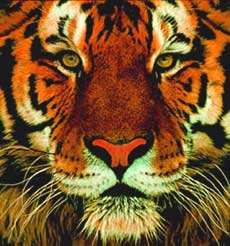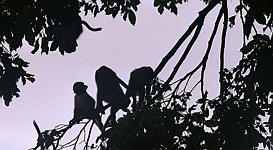|
Travelogues Land of Roar & Trumpet
|
|||||
I love the Corbett Tiger Reserve and have walked its sal forests in the company of one of its most ardent protectors, Brijendra Singh, whose entire life has been spent in defence of the tiger.
Corbett is the ultimate tiger haven, but because of its thick undergrowth and tall grass it is actually quite difficult to spot tigers here so those who consider a trip wasted unless they have seen a tiger might like to think twice about venturing into this paradise!
Speaking for myself, the Ramganga river, otters, gharials, elephants and a distinct chance of spotting something like 200 bird species in a three day span are more than enough to keep pulling me back to this spectacular haven.
|
About Uttaranchal • Overview • Corbett Park
Wildlife Travelogues
More on Wildlife
Environment | ||||
Elephants are however the dominant mammals of Corbett. But even these are dwarfed by the larger-than-life vistas. They can be seen bathing, drinking and feeding in the Ramganga River and its food-rich surrounds. Herds are seen as frequently as lone tuskers. You could chance upon them in thick vegetation or watch them from a distance from machans built over salt licks and water holes throughout the park. Elephants once used to migrate out of the park, but the Ramganga reservoir has cut off one migratory route and some herds are now confined.
Bharal, goral, Himalayan tahr and serow can be seen. In the Bijrani area, chances of seeing sloth bear are excellent. Attracted by both termites and the sweet nectar of mahua flowers, the bears often seem inebriated.
Jackals often come right into the Dhikala campus, where they seem to thrive on small rodents and mammals such as blacknaped hare that live in the grassy chaurs. A wildboar or two has also been spotted rooting about for food scraps left behind by unthinking tourists.
Those of you who have the good sense to find the time and energy to visit the Corbett National Park will probably come away happy and humbled by the sheer beauty of this wilderness, a magical creation of nature that human hands had nothing at all to do with.
Courtesy: Sanctuary Magazine
|
|||||
Editor: Romola Butalia (c) India Travelogue. All rights reserved. |
|||||
 Corbett does, of course, support a fairly large tiger population, estimated to range between 90 and 120. I have even seen one on the main tar road between the Dhangari entrance gate and Dhikala. Apart from the tiger, visitors to Corbett might see as many as 50 different species of mammals. Leopards tend to frequent hilly areas such as Kanda and can also be spotted on the outskirts of the park, because the larger and more powerful tiger dominates the prime areas. The jungle cat and the rare fishing cat frequent grassland and riverine areas.
Corbett does, of course, support a fairly large tiger population, estimated to range between 90 and 120. I have even seen one on the main tar road between the Dhangari entrance gate and Dhikala. Apart from the tiger, visitors to Corbett might see as many as 50 different species of mammals. Leopards tend to frequent hilly areas such as Kanda and can also be spotted on the outskirts of the park, because the larger and more powerful tiger dominates the prime areas. The jungle cat and the rare fishing cat frequent grassland and riverine areas.
 Relatively easily visible are chital, sambar (the largest deer in Asia) and barking deer. Wildboar may suddenly cross the jungle road as you travel. Huge males wander in sounders with females accompanied by striped and marked piglets. If startled by your presence, the group often takes a moment or two from their foraging to regroup and make their getaway into the undergrowth almost in single file. Large male boars can be dangerous if cornered and have been known to fatally wound tigers in battle.
Relatively easily visible are chital, sambar (the largest deer in Asia) and barking deer. Wildboar may suddenly cross the jungle road as you travel. Huge males wander in sounders with females accompanied by striped and marked piglets. If startled by your presence, the group often takes a moment or two from their foraging to regroup and make their getaway into the undergrowth almost in single file. Large male boars can be dangerous if cornered and have been known to fatally wound tigers in battle. The call of the barking deer and chital that are all too often seen in association with the langur are typical of the ambience of Corbett.
The call of the barking deer and chital that are all too often seen in association with the langur are typical of the ambience of Corbett.